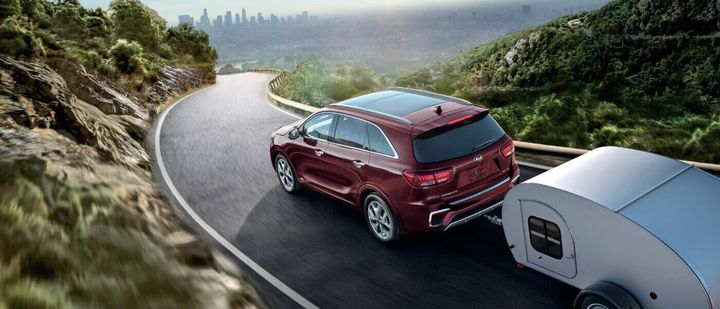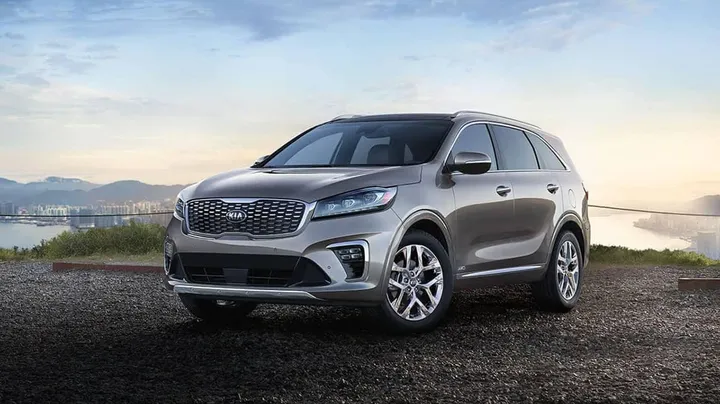


Towing capacity is a critical factor to consider when purchasing a vehicle intended for hauling trailers, boats, or other heavy loads. The Kia Sorento, a popular mid-size SUV, stands out with its remarkable towing capabilities, making it a versatile choice for families and outdoor enthusiasts alike. In this comprehensive article, we'll dive deep into the Sorento's towing capacity specifications, explore the factors influencing towing capacity, provide essential towing safety tips, highlight towing accessories and equipment, and discuss real-world towing scenarios.

The latest Kia Sorento model offers three distinct towing capacity ratings to cater to various towing needs:
| Towing Capacity | Weight |
|---|---|
| Unbraked Towing Capacity | 750 kg (1,653 lbs) |
| Braked Towing Capacity | 1,350 kg (2,976 lbs) |
| Maximum Braked Towing Capacity | 2,000 kg (4,409 lbs) |
The unbraked towing capacity refers to the maximum weight a vehicle can tow without a separate braking system on the trailer. This capacity is suitable for smaller trailers or loads that do not require additional braking assistance.
For heavier loads that necessitate a separate braking system, the Sorento's braked towing capacity ensures that the vehicle can safely tow trailers or loads equipped with their own braking systems, providing enhanced control and stopping power.
The maximum braked towing capacity represents the absolute maximum weight the vehicle can tow when properly equipped with a braking system on the trailer and other necessary towing accessories.
Several factors contribute to a vehicle's towing capacity, and understanding these factors is crucial for safe and efficient towing.
Gross Vehicle Weight Rating (GVWR): The GVWR represents the maximum weight a vehicle can safely carry, including passengers, cargo, and the vehicle's curb weight. Exceeding the GVWR can compromise the vehicle's handling, braking, and overall safety.
Gross Combined Weight Rating (GCWR): The GCWR is the maximum allowable weight of the fully loaded vehicle and the attached trailer or load. This rating takes into account the weight of the vehicle, passengers, cargo, and the trailer or load being towed.
Curb Weight: The curb weight is the weight of the vehicle without any passengers, cargo, or additional loads. A higher curb weight can reduce the available capacity for towing, as it leaves less room for additional weight from passengers, cargo, and the trailer or load.
Engine Power and Torque: Vehicles with more powerful engines and higher torque outputs are generally better equipped to handle heavier towing loads. The engine's ability to generate sufficient power and torque is crucial for maintaining control and acceleration while towing.
Transmission Type: The type of transmission plays a significant role in towing capacity. Automatic transmissions with more gears and higher torque capacities can better handle the additional strain of towing compared to manual transmissions or those with fewer gears.
Suspension and Braking Systems: Robust suspension and braking systems are essential for maintaining control and stopping power when towing heavy loads. Vehicles with heavy-duty suspension components and larger brakes are better suited for towing applications.
While the Kia Sorento offers impressive towing capabilities, it's crucial to follow proper safety guidelines and best practices when towing to ensure a safe and enjoyable experience.
Ensuring that the trailer is properly hitched to the vehicle and that the load is evenly distributed is essential for safe towing. Improper hitching or uneven load distribution can cause trailer sway or loss of control, potentially leading to dangerous situations.
Here are some key considerations for proper trailer hitching and load distribution:
Use a high-quality trailer hitch and tow bar that are rated for your vehicle's towing capacity and compatible with your trailer.
Follow the manufacturer's instructions for proper hitching and load distribution.
Distribute the load evenly across the trailer, with heavier items placed closer to the hitch.
Ensure that the trailer's tongue weight (the weight exerted on the hitch by the trailer) falls within the recommended range for your vehicle.
When towing, it's advisable to reduce your speed and adjust your driving techniques accordingly. Follow the manufacturer's recommended towing speeds and driving techniques, which may include:
Avoiding sudden acceleration or braking
Maintaining a safe following distance
Using lower gears when descending hills
Allowing for longer stopping distances
Being aware of wind conditions and adjusting your driving accordingly
Regular maintenance and inspection of your vehicle, trailer, and towing equipment are essential for safe towing. Here are some key points to consider:
Check for worn or damaged components and replace them as needed.
Ensure that all lights, brakes, and safety systems are functioning properly before embarking on a towing journey.
Follow the recommended maintenance schedule for your vehicle and trailer.
Inspect tires for proper inflation and tread depth.
Check fluid levels and top up as necessary.
Be aware of and comply with all legal requirements and regulations related to towing in your area. These may include:
Licensing requirements
Trailer lighting regulations
Weight restrictions
Speed limits for towing
Safety guidelines specific to your location

To enhance the towing experience and ensure safety, consider investing in appropriate towing accessories and equipment.
| Accessory | Description |
|---|---|
| Trailer Hitches and Tow Bars | Choose a high-quality trailer hitch and tow bar that are rated for your vehicle's towing capacity and compatible with your trailer. Proper installation and regular maintenance of these components are essential for safe towing. |
| Trailer Brakes and Wiring Harnesses | For heavier loads, trailer brakes and wiring harnesses can improve braking performance and control. These accessories allow the trailer's brakes to be synchronized with the vehicle's braking system, providing additional stopping power and stability. |
| Trailer Mirrors and Backup Cameras | Trailer mirrors and backup cameras can significantly improve visibility and make maneuvering with a trailer easier and safer. These accessories provide a clear view of the trailer and its surroundings, reducing blind spots and increasing overall awareness. |
| Weight Distribution Hitches and Sway Control Devices | Weight distribution hitches and sway control devices can help distribute the trailer's weight more evenly and reduce the risk of trailer sway. These accessories can improve handling, stability, and overall control when towing heavy loads. |
The Kia Sorento's towing capacity makes it suitable for a variety of real-world scenarios, catering to the needs of families and outdoor enthusiasts alike.
With its maximum braked towing capacity of 2,000 kg (4,409 lbs), the Sorento can comfortably tow many small to mid-size campers or travel trailers. This capability makes it an excellent choice for family camping trips or weekend getaways, allowing you to bring along the necessary amenities and equipment for a comfortable outdoor experience.
Some popular camper and travel trailer models that fall within the Sorento's towing capacity include:
Jayco Jay Feather X17Z (Dry Weight: 1,588 kg / 3,500 lbs)
Coachmen Clipper C12RB (Dry Weight: 1,451 kg / 3,200 lbs)
Airstream Bambi 16RB (Dry Weight: 1,406 kg / 3,100 lbs)
Outdoor enthusiasts can take advantage of the Sorento's towing capabilities to transport small boats, personal watercraft, or other recreational equipment to their desired destinations. Whether you're heading to a nearby lake or embarking on a fishing adventure, the Sorento can handle the load with ease.
Here are some examples of boats and personal watercraft that fall within the Sorento's towing capacity:
Bayliner Element E16 (Boat Weight: 726 kg / 1,600 lbs)
Sea-Doo GTX Limited 300 (Dry Weight: 408 kg / 900 lbs)
Yamaha EX Sport (Dry Weight: 272 kg / 600 lbs)
The Sorento's towing capacity also makes it a viable option for hauling heavy equipment or machinery, such as lawn mowers, ATVs, or small construction equipment. This versatility can be particularly useful for work or personal projects that require the transportation of heavy loads.
Some examples of equipment and machinery that can be towed by the Kia Sorento include:
Lawn Tractor (Weight: 454 kg / 1,000 lbs)
Compact Utility Tractor (Weight: 907 kg / 2,000 lbs)
Skid Steer Loader (Weight: 1,814 kg / 4,000 lbs)
The Kia Sorento's impressive towing capacity, combined with its versatility and safety features, makes it an excellent choice for individuals and families who require a capable and reliable towing vehicle. By understanding the factors influencing towing capacity, following safety guidelines, and utilizing appropriate towing accessories, you can enjoy a safe and efficient towing experience with your Kia Sorento. Whether you're planning a family camping trip, hauling recreational equipment, or moving heavy machinery, the Sorento's towing capabilities can accommodate your needs, ensuring a seamless and enjoyable journey.
The Kia Sorento has a maximum braked towing capacity of 2,000 kg (4,409 lbs). The unbraked towing capacity is 750 kg (1,653 lbs).
The Gross Vehicle Weight Rating (GVWR), Gross Combined Weight Rating (GCWR), curb weight, engine power and torque, transmission type, and suspension and braking systems all contribute to a vehicle's towing capacity.
Ensure proper trailer hitching and load distribution, follow recommended towing speeds and driving techniques, perform regular maintenance and inspections, and comply with legal requirements and regulations related to towing.
Recommended accessories include trailer hitches and tow bars, trailer brakes and wiring harnesses, trailer mirrors and backup cameras, and weight distribution hitches and sway control devices.
The Sorento can tow small campers or travel trailers, small boats or personal watercraft, and heavy equipment or machinery within its towing capacity limits.
The Sorento's towing capacity is competitive with other mid-size SUVs, offering a higher towball download limit and a full-sized spare tire, which can be advantageous for towing.
The article does not specify a recommended towing speed for the Kia Sorento. However, it advises following the manufacturer's recommended towing speeds and driving techniques.
The article does not provide specific towing capacity ratings for different Kia Sorento models. It mentions that the towing capacity may vary based on factors like engine choice and trim level.
The towball download limit is crucial because it determines the maximum weight that can be placed on the tow hitch, affecting the vehicle's stability and control when towing. A higher towball download limit can make it easier to achieve the desired weight distribution.
The article advises being aware of and complying with legal requirements and regulations related to towing in your area, such as licensing requirements, trailer lighting regulations, weight restrictions, speed limits for towing, and safety guidelines specific to your location.

Sarah isn't your average gearhead. With a double major in Mechanical Engineering and Automotive Technology, she dived straight into the world of car repair. After 15 years of turning wrenches at dealerships and independent shops, Sarah joined MICDOT to share her expertise and passion for making cars run like new. Her in-depth knowledge and knack for explaining complex issues in simple terms make her a valuable asset to our team.



